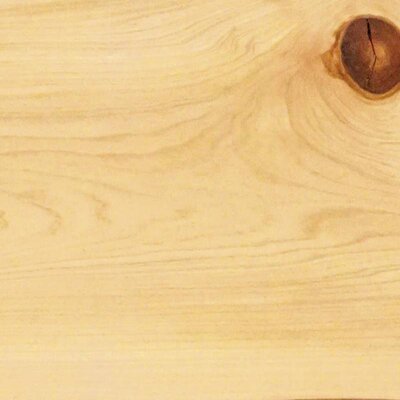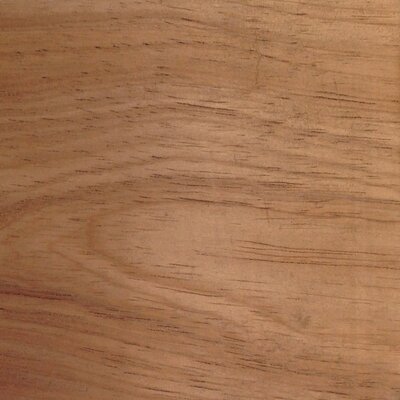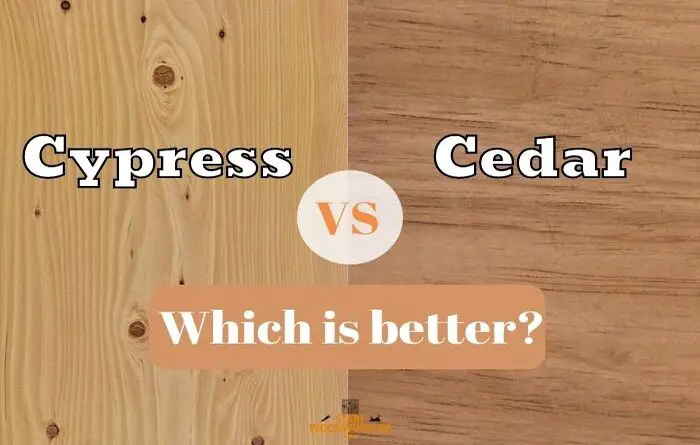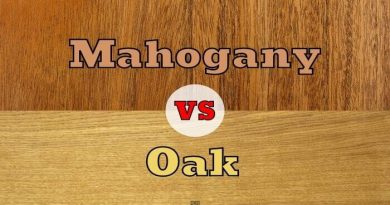Cypress vs Cedar (Which is the Best? | Pros & Cons)
Cypress vs Cedar: Which is the Best? Many people have asked us this question. Because of this we will try to answer it.
We do not believe that cedar is better than cypress, or vice versa. These are two woods with important differences, although both with excellent characteristics.
Cypress
The Cypress is native to the eastern Mediterranean region, from where it has spread throughout southern Europe since ancient times. It grows in hot climate areas with dry summers and adapts to different terrains, lending itself to reforestation of arid, calcareous or landslide soils, often also with a landscaping function.
Cypress wood is a fragrant wood, very hard, with beautiful shades of pale red with brown grains. This native wood comes from a tree of the Conifer family.
Here are different types of cypress woods:
- Arizona cypress
- Monterey cypress found in the California area, it is grown in both North America and Europe.
- Mexican cypress found in the south of the United States and in Mexico.
- Mediterranean cypress
- Leyland cypress (Cupressus x leylandii)
- Himalayan cypress
Leyland cypress is a hybrid between the Monterey cypress and the Alaskan cypress. It adapts very well to different climates and also grows quickly.
The real cypress comes mainly from the Mediterranean area. Other cypress species, which can be more or less closely related, occur in all areas of the world that have a warm climate.
Cedar
Cedar is by far one of the most popular types of wood used by homeowners, contractors, and suppliers. Many believe that wood is the best option as it is an extremely low maintenance solution that looks great with any home and style.
Cedar wood is particularly popular as construction wood for inside and outside. In addition to being easy to work with for doors or shutters, the essential oils contained in the wood protect the wood from insects and pests and are also suitable as a pleasant cedar wood fragrance in cosmetics.
Depending on the species, this tree can measure between 50 and 20 meters in height, and some specimens have exceeded 2,000 years of age.
There are several species of cedar, we can find the Cyprus, Atlas, Lebanon or Himalayan cedar, however, the most commercialized cedar is the western red cedar also known as Spanish, Canadian or Pacific cedar.
Red western cedar stands out, whose characteristics are described below grows can be found in North America, Central America and South America.
Cypress vs Cedar: Color
Cypress Color

Cypress wood is characterized by a brownish yellowish color with darker brown heartwood and an irregular outline. Free of resin canals, it has a strong scent given to it by the ethereal oils contained which are found in the resin confined in the layer of the bark.
It has a very fine texture with not very regular fibers due to the accentuated and large knotty.
The wood of the cypress has a whitish, up to 10 cm wide sapwood and a yellowish brown core. The texture is simple, without resin canals, with more or less distinct tree ring borders. Cultivated species have wider annual rings.
The color of the wood is light yellow in the sapwood and in the heartwood it has a pinkish hue or is a light tobacco color when it ages. The grain is usually straight, however, it has irregularities due to the large number of knots and the grain is fine. It is an aromatic wood with a strong and persistent smell
Cedar Color

Cedar wood stands out for its shades ranging from pink to yellow in the sapwood and from yellow to reddish brown in the heartwood.
Real cedar wood is characterized by its unique color between the early and late wood. While the heartwood ranges from a light brown to a reddish color, the sapwood of the wood is light and almost white.
This difference in colors can be seen in the cross section using the fine annual rings. The grain of the cedar wood can therefore be described as fine, even and harmonious.
The yellow-brown-red-brown wood is mainly found on the west coast of North America and scores both indoors and outdoors with its appearance and resistance to fungi.
The thin pink or grayish sapwood clearly differs from the reddish yellow or brown red heartwood with frequent gum-resinous exudations. It has a slightly acrid taste and, when fresh, it gives off a pleasant scent of cedar.
I have another interesting comparison between birch and beech! You definitely need to see this one!
What is the difference between Cypress and Cedar?
When it comes to color of cypress vs cedar on a surface level, cedar and cypress trees resemble each other. The difference between cypress and cedar comes from the density : cypress is slightly more dense than cedar wood.
Cedars are best known for their aromatic wood, as it produces a type of oil that gives cedar wood its strong scent. On the other hand cypress wood have a distinctive scent when cut. Some describe the smell as earthy; others say it smells like cedar and some references call it sour smell.
Also the cypress oil does not have as strong of a scent as cedar oil, which is a bonus for people who have allergies to cedar oil.
However, they are two distinct classes of trees that are not very closely related taxonomically. They share the subclass Pinidae, but are in different orders.
Cypress belongs to the genus Taxiodium located in the Cupressaceae family. Many trees that are called cedars but “true” cedars of the genus Cedrus are found in the Pinaceae family within the order Pinales.
Cedar is actually an evergreen tree. Its natural range extends throughout the world, and cedar adapts to many different climates. The cypress is deciduous and is found mainly in the southern wetlands. Cypress sometimes spend long periods of time flooded well above their base level. Its root system is well adapted for this lifestyle, which has irregularly shaped “knees” that project out of the water.
Do you know how to properly oil a wooden floor? Do you know the steps required? Check this easy guide I wrote to help you succeed!
Cypress vs Cedar: Comparison Table
| Proprieties | Cypress | Cedar |
|---|---|---|
| Appearance | Heartwood pale yellow to brown with clearer sapwood. | The color goes from light pink to yellow in the sapwood to yellow and reddish brown in the heartwood. |
| Durability | Durable against moisture, insects and fungi. Janka 430-550 lbf. Semi-hard wood. | Naturally durable and resistant to the attack of fungi and insects. Janka 720-900 lbf. |
| Workability | Sawing is difficult both because of the numerous knots and the irregularities of the grain. It is not a good option for bending. | It is a wood that is easily worked with, both with tools and manually. Easy sawing and planing. |
| Density | It has a density of 500 kg / m3. Other types of cypress can be between 450-550 kg /m 3 . | It is light, with a weight that is between 490-520 kg /m 3 at 12% humidity. |
| Drying | Drying is easy but must be done slowly, there is a high risk of tearing and throwing. | Slow drying with little probability of deformation. |
| Suitability for assembly | Nailing and screwing may require pre-drilling to prevent cracking. | Gluing without problems , except if resin residues appear. Nailed and screwed without difficulty. |
Here is a wood comparison between mahogany and oak in case you need it!
Cypress vs Cedar: Durability
Cypress Durability
Cypress is a precious wood of excellent quality: strong, durable, with limited dimensional variations that make it very stable. It is characterized by a brownish yellowish color with darker brown heartwood with an irregular outline, it is devoid of resin canals, has a strong scent given to it by the ethereal oils found in the bark and is resistant to parasites.
Cypress is extremely hard, quite compact, very solid, and long lasting. Because cypress has no layers it does not crack or warp and can be cut across and also lengthwise.
When dried, the wood has a density of about 470 kg / m3. Emits a faint cedar-like odor. Despite its low density, cypress wood is durable and resistant to external influences.
Cypress wood is weatherproof and resistant to fungal and insect attack, and also very durable. It can therefore be used outdoors without any problems.
The long durability allows cypress wood to be used for windows exposed to the elements, since the extractives that give it the particular scent show an effective antiseptic action that prevents attacks by both fungi and insects.
Cedar Durability
The wood of the cedar is known for its rather light, not very hard texture. It is almost impossible to bend and can be marked with a medium elastic hardness. However, the heartwood is only moderately weather-resistant and the split wood is susceptible to insect infestation.
In spite of all this, cedar wood is very durable, as it is also very resistant and durable in water, and there it also increases in hardness. It shrinks moderately, dries easily and quickly and stands out due to its very good workability.
Cedar wood has a density of between 550-580 kg / m³, and is considered semi-hard. Cedar wood only shrinks moderately, dries quickly and easily.
Real cedar wood is very waterproof and when submerge in water it increases in hardness.
If you have a façade siding or interior wall siding project, and you love the beautiful and naturally durable, go with Western Red Cedar. Its characteristics combining nobility, aesthetics, and natural durability are all assets for an exceptional achievement.
The wood of the real cedar scores with its expectorant and antiseptic properties. That is why it is mainly used for diseases of the respiratory tract and other infections. Whether against moths and lice or as an insole to prevent foot odor, it is versatile and effective.
As we have said before, cedar wood is considered durable, this virtue makes it a wood with excellent outdoor performance. This characteristic, added to the moderate price and its robust aesthetics, makes it a highly demanded wood for the manufacture of structures and for outdoor furniture.
Want to know top 15 hardest woods in the world? If yes then you have to check this amazing list!
Cypress vs Cedar: Uses
Cypress Uses
Cypress wood is used in:
- Furniture.
- Interior and exterior carpentry.
- Firewood.
- Posts and fences.
- Boats.
- Musical instruments. Mainly guitars.
- Decorative sheets.
- Turning.
These trees are widely used in ornamentation and wood production, such as in carpentry, carpentry and in the making of musical instruments, due to their resistance to decay and pests. Most of these trees are grouped in the genera Cupressus and Chamaecyparis .
Cypress wood is sometimes only available in small quantities today, despite the worldwide occurrence of the species. Some cypress wood is used as construction wood, and there are also numerous possible uses in interior and exterior construction, such as in door and window construction.
Cypress wood is also very valued as a wood turner and is occasionally used for carving. It is also used for cement-bonded wood wool panels.
Like cedar, cypress wood is also popular for outdoor applications. Cypress produce a different oil, which has a preservative function. This oil does not have as strong of a scent as cedar oil, which is a bonus for people who have allergies to cedar oil. Cypress wood is also naturally straight grained and is slightly more dense than cedar wood.
Cypress tree plantations are useful in agriculture. They are often planted as a protective barrier to absorb agricultural runoff.
Another use of considerable value is the manufacture of furniture, such as chests and wardrobes, intended for the storage of clothes and fabrics. Also prized for handicrafts, turning and small fine objects
The use of cypress wood is due to its good mechanical characteristics and excellent biostability. In addition, cypress wood has a pleasant looking texture.
Therefore, the use of cypress wood is also possible for the exterior: fences, roofing boards, siding, shutters and other finishes, as well as for the interior as lining , sheathing, simple or elegant furniture, massive boards, parquet or décor items. Cypress veneer is widely used.
Cedar Uses
Cedar wood is used in:
- Manufacture of quality interior and exterior furniture
- Interior carpentry: doors, moldings, baseboards.
- Floors;
- House construction widely used in North America for this purpose.
- Making of musical instruments;
- Crafts: cigar boxes, toys.
- Manufacture of boats.
Its use in cosmetics would provide relaxing, healing, decongestant benefits. It is often used to make furniture or various furnishing elements. Nowadays Cedar wood finds various uses in industrial sectors and is highly appreciated for the composition of furniture and wardrobes.
Older furniture makers use cedar wood for its distinctive scent that makes it perfect for linen drawer bases or wardrobes linings. Cedar wood is able to release a strong essence that immediately strikes the human sense of smell, it is the perfect material for those who want to furnish the home environment in the best possible way as it is light and at the same time highly resistant and for those who want long-term safety and resistance.
One of the best uses for cedar wood is outdoor because it’s offering the best quality / price ratio. There are better woods and there are also cheaper ones. But we will hardly find a better option for exteriors at the price of cedar wood.
Cedar is used in many construction products, such as siding, decking, fences, shingles, gazebos, trim, sheds, doors, windows, blinds, planters and is a wood that is largely comparable to pine and spruce.
Cedar products can be left without finishing or painting, but will always require periodic maintenance. Of course, many light cedar wood products can also be stained and painted without losing their grainy appearance, making this wood a versatile option.
Want to learn how to stain wood ? I’ve got for you the best tutorial so you don’t make any mistake!
Is cypress more rot resistant than cedar?
Cedar is a durable, light wood that is quite resistant to rot, fungi and insects. Cypress is overall more rot resistant than cedar because only the heartwood of the cedar is rot resistant while the sapwood is not.
It is also important that cedar is a natural antiseptic, and therefore in the house, which was built from its wood, there are no harmful bacteria, and the air is almost sterile.
Is cypress better than cedar?
Old cypress wood is considered to be very durable more durable than cedar but it’s hard to find and expensive. Younger cypress is considered moderately durable.
Old Cypress wood is dense, fine-grained and hard but cedar is more durable and more easy to work with. On the other hand cypress is easier to work by hand.
Cypress vs Cedar: Workability
Cypress Workability
It has a very fine texture that allows a high degree of finish, with a not very regular grain due to the accentuated and large knotty. Sawing and planing is difficult both because of the numerous knots and the irregularities of the grain. It should be dried slowly to avoid cracking and collapse phenomena. The peeling is not practiced and for the shearing you need knot-free pieces, difficult to find.
Cypress wood can be worked well by hand and machine. It is suitable for painting and offers wood connections such as nails, screws and adhesives a good hold. Note the difference between wood from natural resources and wood from plantations. The latter has a wider ring and is therefore less firm.
Cypress is easy to work with, but the many branches sometimes cause difficulties. Wood joints with nails and screws are durable, but pre-drilling should be done to avoid splicing. The wood is well suited for turning.
Cypress can be worked, turned and polished easily by hand as well as with the machine.
Cedar Workability
Although not very easy to work (due to its irregular shape and the frequent curvatures of the trunk), cedar finds a relatively wide use in the manufacture of fine furniture , but also of ornaments and ornaments.
The beautifully colored, fragrant, durable wood is relatively soft, but has fairly dense fibers and does not shrink much. It even increases in hardness and durability under water. Its aromatic, floral scent keeps insects away. Reddish in color, cedar wood radiates warmth and is easy to work with.
Cedar wood is distinguished by its high strength and at the same time softness, due to which it is quite easy to process, therefore it is actively used in construction as a finishing material.
Cedar can be cut easily both along and across it’s wood fibers and this property means it does not chip.
Cypress vs Cedar: Advantages and Disadvantages
Cypress wood Advantages
The advantages of cypress wood are:
- Grows fast
- Highly durable wood
- Can be easily worked with tools
- Attractive color
Cypress wood Disadvantages
The disadvantages of cypress wood are:
- High price
- Needs to be stained
Cedar wood Advantages
Present in construction since antiquity, cedar has many advantages:
- Rot-proof, excellent durability in its natural state: class 3;
- Good “mechanical” behavior in its area of origin;
- Weatherproof
- Resistant to decay
- Undeniable aesthetic qualities (fineness of the grain, color, etc.).
Cedar wood Disadvantages
The disadvantages of cedar wood are:
- Heavier than other woods
- It is not a malleable type of wood
- Difficulty in dyeing
Conclusion
When it comes to cypress vs cedar wood take a look at each advantages and disadvantage and choose the wood that suits your needs. Both cedar and cypress have similar strengths and weakness and I think it all comes down to the color, appearance and use.




